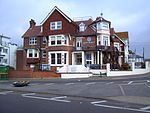Southend-on-Sea War Memorial, or Southend War Memorial, is a First World War memorial in Southend-on-Sea, Essex, in south-eastern England. It was designed by Sir Edwin Lutyens and unveiled in 1921. Southend-on-Sea is a seaside resort famous for its pleasure pier, which was used by the military during the First World War. The town was a stopping point for soldiers en route to the front and, as the war drew on, it also became an important disembarkation point for the evacuation of injured troops. This saw the conversion of several buildings in Southend into hospitals.
A committee appointed Lutyens, the architect of The Cenotaph, to design a permanent memorial as a replacement for temporary shrines. He originally proposed a cenotaph but this was rejected in favour of an obelisk rising from a screen wall. In front of the monument is a garden, also designed by Lutyens, and the words "lest we forget" are set in stone on a lawn. Instead of carving them on the memorial, the names of the 1,338 dead from Southend are recorded on plaques fixed to the walls of Prittlewell Priory. The memorial is one of six obelisks Lutyens designed for war memorials in Britain and closely resembles those for Northampton and for the North Eastern Railway. It was largely praised by art historians but one Lutyens biographer felt the lettering in the grass detracted from it.
The memorial was unveiled on 27 November 1921 by the Lord Lieutenant of Essex and dedicated by the Bishop of Chelmsford in front of a large crowd. Invited guests included the mayor, local clergy, veterans from the district, and organisations which had contributed to the war effort in the area. The memorial became a listed building in 1974. Lutyens's memorials were declared a national collection in 2015 to commemorate the centenary of the war and Southend's was upgraded to grade II*. A statue of a soldier was added in 2019.










